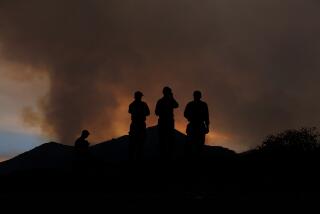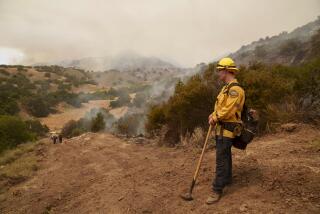Blaze Claims Dozens of Colo. Homes
- Share via
COTOPAXI, Colo. — Stunned homeowners surveyed the charred path of a voracious forest fire Monday that within 24 hours leveled at least 81 homes so quickly that residents raced to flee ahead of the flames.
“How do I feel? I don’t know. I’m in shock,” said Kevin Gobell, who lost his home. He said he stood Monday on its foundation, the only remaining trace of the structure.
Lin Frost said she and her husband awoke from a nap Sunday afternoon, heard commotion and went outdoors to discover a heart-grabbing sight: “Our neighbor was running down his driveway, waving his arms and screaming, ‘We’re on fire!’ I looked up and saw enormous columns of black smoke coming up. It was breathtaking.”
The blaze, on the eastern slopes of the Rocky Mountains 130 miles southwest of Denver, is called the Iron Mountain fire. It has been by far the most destructive wildfire this year. A fire in southern New Mexico burned 28 homes in April, a blaze that marked the early beginning to the fire season.
By Monday evening, the fire had consumed about 4,400 acres, destroyed at least 100 structures, including a general store, and was about 30% contained, said incident commander Kim Martin.
The fire was one of two extreme blazes hounding firefighters in southern Colorado. Along the New Mexico border south of Trinidad, Colo., a 19,000-acre fire was burning through mountainous fields that contained nearly 500 methane gas wells. Several hundred homes along the Purgatory River were threatened, but none had burned, firefighters said.
The Iron Mountain blaze fed on timber that was described as drier than kiln-dried lumber, and it further feasted on a particular kind of oil-rich oak shrub.
“It took off and screamed through the forest and incinerated everything in its path,” said Ron Gosnell, a fire information officer. “A fireball blew over a trailer without burning it, but it was so hot, it melted the vinyl siding. Melted vinyl was hanging in gobs by the nails.
“Our most experienced firefighters were just shaking their heads, saying they’ve never seen a fire like this one, burning so quickly and so fiercely.”
Residents heard similarly grim news when they gathered at the local high school gymnasium for a Monday evening briefing. The room stank of smoke and sweat; residents fanned themselves with papers.
A teary-eyed Ilene Dugger, unsure whether her own home was still standing, stood up at the meeting and said: “I don’t have a job right now, so I’ve got plenty of time on my hands. If anybody needs any help, I’m here.”
In the school’s auditorium, blankets and mountains of clothes were piling up on the stage, donated by community residents. Outside, insurance companies already had set up emergency response tables; on a bulletin board, telephone messages were being left for people who had lost electricity and phone service. Local ranchers offered to take care of livestock and household pets. Scores of dogs loped around the campus.
The American Red Cross was offering medical help and counseling. Jill Anderson, the local coordinator, understood that for all the formal assistance that would soon be poring into the town, the Red Cross had something immediate to offer. “If you want to sit down and drink a cup of coffee and cry,” she said, “we’re here for you.”
Fremont County Sheriff Ivan Middlemiss said his deputies struggled to compile a list of destroyed homes.
“Quite frankly, there was more damage than I anticipated,” he told the crowded gymnasium. “The devastation is total. It looks like the surface of the moon. Everything is ash. There were no street signs, no identifiers. Basically, all we’ve got are foundations.”
Firefighters spent most of Monday attacking the fire from the air, and they hoped to extend the fire line around it today as more firefighters arrive. Improved weather, with higher humidity and possible rain, was forecast.
Officials expect lower winds today. Unpredictable winds hampered firefighting efforts Monday. “The winds were changing on us all the time,” said Fremont County Sheriff’s Sgt. Robert Williams. “They’d go north, then east, then back north, and we have homes in all directions.”
The homes that burned were widely scattered across private forest lands in this popular recreation area. Structures that were destroyed ranged from mobile homes on 2-acre lots to quarter-million-dollar forest chalets on 35-acre wooded parcels, shrouded by pinyon and ponderosa pines, juniper trees and gambel oaks, said Williams.
One homeowner acknowledged the challenge of keeping cleared space between trees and homes--and didn’t even try. “I was afraid that the chainsaw would cause sparks,” said Daryl Frost.
By Monday afternoon, the fire had crept to within about 6 miles of the photogenic Royal Gorge Bridge, which is suspended 1,053 feet above the Arkansas River and is popular among white-water rafting enthusiasts.
To the south, firefighters in Colorado’s largest county, Las Animas, were battling three sets of fires, the most troublesome of which was crawling through junipers, pinyon pines and brush that carpeted a sprawling methane gas field.
“None of the wells have caught on fire, none have blown,” said Sheriff Lou Girodo. “These are pretty good people running these gas wells. They have good safety factors built in.”
Girodo said the blaze had destroyed at least one and maybe two cabins, and that officials would be able to better assess the damage today. “It’s so smoky in there, you just can’t see anything,” he said. “The smoke has pretty much put Trinidad out of business.”
The sheriff said about 300 firefighters were expected to be on the fire lines by today.
“It’s going to get bigger,” he said. “It’ll lay down tonight when the temperatures cool, but in the morning, when the temperatures rise and the humidity drops to single digits, it’ll drive that fire right down the canyons and it’ll get larger.”
So far this year, more than 1.2 million acres have burned across the West, well above the 10-year average of 750,000 acres by this time of year.
Firefighters from across the U.S., from New Jersey to California, are at a heightened level of preparedness because sustained droughts have dried vegetation.
Currently, 28 large fires are burning in 12 states.
Cart reported from Cotopaxi and Gorman from Santa Fe, N.M. Times researcher Belen Rodriguez in Denver contributed to this report.
More to Read
Sign up for Essential California
The most important California stories and recommendations in your inbox every morning.
You may occasionally receive promotional content from the Los Angeles Times.














